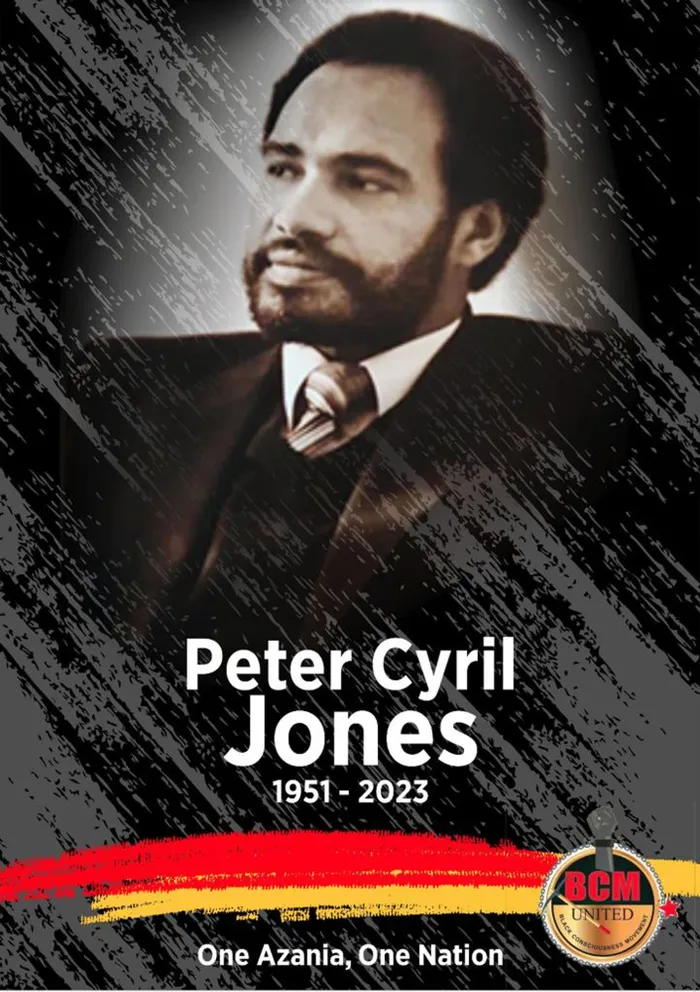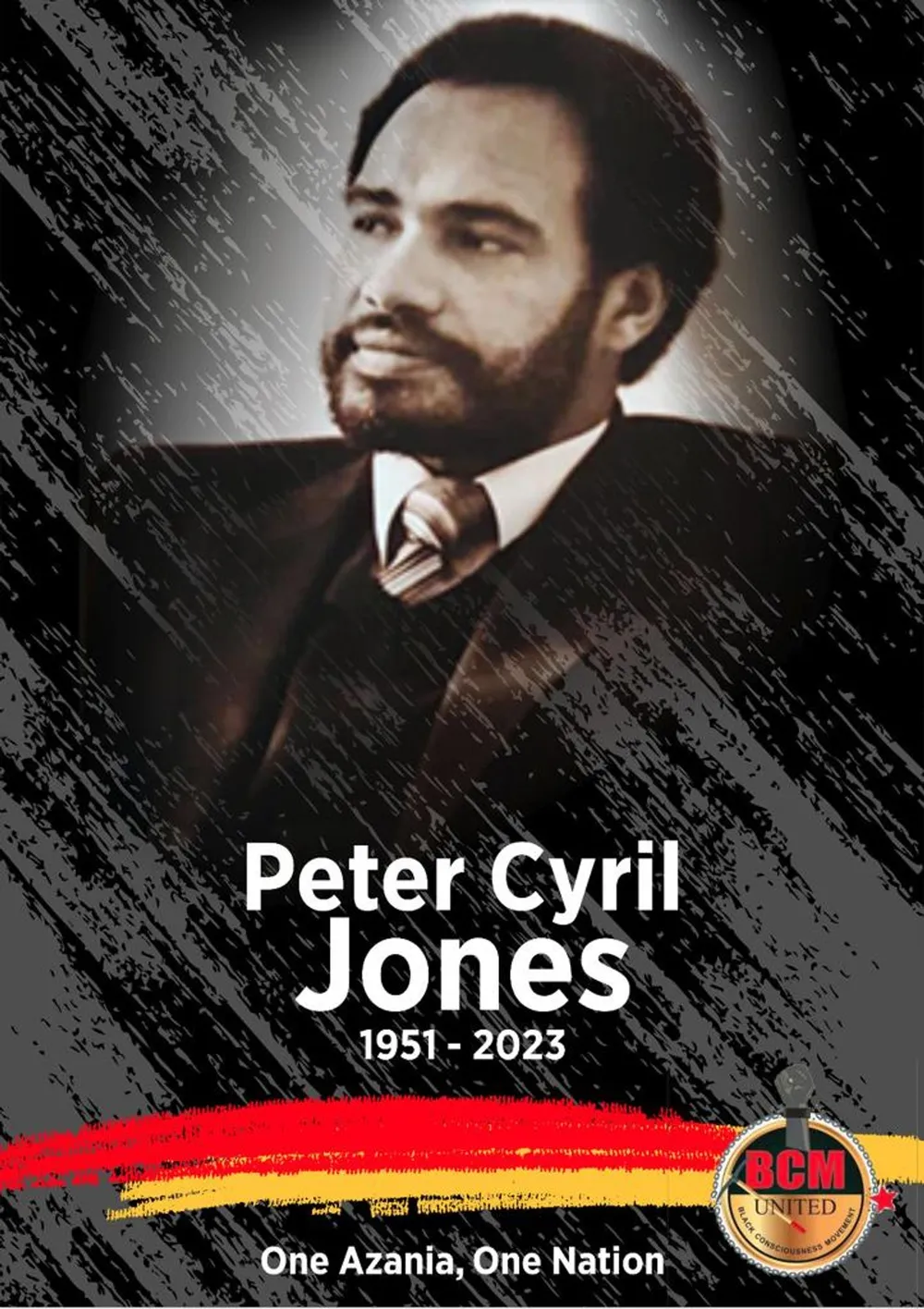Peter Jones and Africanism - An unsung hero who made being black beautiful

Graphic: Timothy Alexander/African News Agency (ANA) – PC, as Peter Cyril Jones was affectionately known, was the right-hand man of Struggle icon and father of Black Consciousness Movement, Steve Bantu Biko. Jones was an unassuming freedom fighter who, at the height of apartheid repression in the late 1960s and throughout the 1970s, was a prominently constant thorn in the side of the white minority regime.
By Abbey Makoe
I find one particular Tswana idiomatic expression quite rich in meaning. It is an age-old piece of African epistemology that goes as follows: “Modiri ga se moji”. Loosely translated, it means: “He who toils, is never a beneficiary of the fruits of his labour”.
That, in my humble opinion, is the total summation of the life and times of Peter Cyril Jones. He was a fearless revolutionary, a dyed-in-the-wool Black Consciousness exponent, a community builder par excellence, and an extraordinary South African who passed away recently at his Pringle Bay home in the Western Cape following a long stroke-related illness. He was 72.
PC, as Jones was affectionately known, was the right-hand man of Struggle icon and father of Black Consciousness Movement, Steve Bantu Biko. Jones was an unassuming freedom fighter who, at the height of apartheid repression in the late 1960s and throughout the 1970s, was a prominently constant thorn in the side of the white minority regime.
He mobilised communities across the length and breadth of South Africa, preaching the Black Consciousness message of self-reliance, pride and self-affirmation. “Black is beautiful” and “Black power” were some of the many rallying slogans that arose a particular consciousness across Black South Africa at the time when blackness was regarded as inferior in race relations and by nature.
Together with hordes of other unsung heroes and heroines of the Black Consciousness Movement era who mobilised blacks to “come out of their shell” of self-doubt and fight to determine their own destiny in the land of their forebears, they faced state terrorism on a daily basis and yet remained steadfast in pursuit of liberation of the Black people.
On September 12, 2013, I was privileged to host Jones at Unisa where we had invited him to deliver the keynote address at the annual Steve Biko commemoration. To say it was an honour will be an understatement. We ate from the palm of his hand as he spoke passionately about the historic final moments that he spent with Biko prior to his murder in police custody on September 12, 1977. To be with Jones felt like being in the presence of greatness.
When news of Jones’ death spread on the social media recently, one of the telling responses was from a young black South African who lamented the total absence of political education around liberation heroes such as Jones. “This is the history that should be taught in schools and heroes such as Jones prominently referenced in daily narratives of the creation of post-apartheid SA,” one person opined, painstakingly.
But then again, the truth about the new SA is that very little is said about freedom fighters that happen to belong to political persuasion that is outside of the present-day ruling party. Jones’ story is in many respects a microcosm of a lopsided story-telling culture that is riddled with half-truths and deliberate falsification of our history.
In as much as Jones has died an unsung hero from the Black Consciousness Movement, there are countless other similar cases in the PAC circles as well as within the governing ANC itself, particularly former fighters in uMkhonto we Sizwe. A case in point is one Tom Sebina, known as “the voice of the ANC in exile” who died miserably in the late 1990s at his Dube, Soweto, home after being deserted by his former comrades, many of who were serving ministers in government and others occupying high positions in the public service.

Such is the sad story of the new SA, where the liberation history is often narrated with conveniently selective memory. As a result a long list of true heroes and heroines, particularly in the Black Consciousness Movement, remains obscured or completely torn out of history pages. They include freedom fighters such as Mapetla Mohapi, Rev Stan Ntwasa, Onkgopotse Tiro, Mthuli ka Shezi, Dr Nchaupe Aubrey Mokoape, Nkosi Patrick “LTD” Molala, Tsietsi Mashinini, Khotso Seatlholo – the list is too long to jot down.
Jones was a man of integrity who was born and bred in abject poverty steeped in racial discrimination. Like many South Africans of colour, his mother, Anne Jones, was a domestic worker who nonetheless instilled in the young Jones a sense of self-worth and fearlessness when approaching the country’s political vicissitudes of life.
In 1969, Jones went to the University of the Western Cape, where he prominently decried the apartheid policies of racial segregation. Jones was classified a “Coloured” under the government’s population register. However, together with Biko and other Black Consciousness Movement leaders, they defined “Black” as a reference to all who were not classified “White”. The result was that Black Africans, Coloureds and Indians clubbed together and referred to themselves collectively as “Blacks”. This development united the three racial groups against the white minority regime of the time, instead of keeping them apart through the government’s policy of “separate development”. Jones was in fact a part of the first generation of SASO (SA Student Organisation) that mobilised across universities. He led SASO at the UWC.
Soon afterwards, as Black Consciousness Movement succeeded in mobilising all Black people against the apartheid state throughout the country, Jones migrated to Ginsberg to join the banned Biko and others like Dr Mamphela Ramphele in becoming part of the building of community projects in the Eastern Cape. These included the famous Zanempilo Health Centre. Many Black doctors who were Biko’s comrades and fellow students at the medical school at the University of KwaZulu-Natal heeded Biko’s call and flocked to Zanempilo to render free health services to the communities. Jones was an integral part of all this.
Other community projects Jones got involved with included Njwaxa Leather Factory, King William’s Town Resource Centre, Umthatha Sewing and Women’s Co-operative and Cape Town’s Black Production. Jone’s belief in Black self-reliance drove him to mobilise communities to pull themselves up by their boot-straps instead of wallowing in self-pity. Like many of his comrades, Jones spent a lot of his time evading police arrest, harassment and even assassination.
In 1971, Jones took up issue with the rapidly increasing number of Black children who were out of school in the Western Cape. At the time, there were only two high schools for African children in the Western Cape, one in Gugulethu and the other in Langa townships. Jones went on to found the Waterkloof Scholarship Fund through which scores of students were sent to further their studies at schools in the far Eastern Cape. Always solution-driven, Jones worked very closely with Biko on projects that they co-founded in Ginsberg, where Biko lived and was frequently banned by the apartheid regime that further restricted his freedom of movement by placing him under house arrest.
Black Consciousness Movement filled the vacuum that had been left by the banning of the ANC and PAC and the SA Communist Party after their banning in the early 1960’s. In 1977, both Jones and Biko drove under the cover of darkness (breaking the banning order and house arrest conditions) to Cape Town to lead talks on efforts to unite all the liberation organisations. On their return to their base in Ginsberg outside King Williamstown, the two were stopped at a specially set-up road block after police were tipped off.
They were arrested near Grahamstown in August 1977 and immediately separated from one another. Jones would later tell the Truth and Reconciliation Committee about severe beatings the police subjected them both to. Biko was later to be driven for more than one thousand kilometres at the back of a police van, chained, bleeding and naked. He was declared dead at the Pretoria Central Prison (now Kgosi Mampuru Correctional Services) on 12 September 1977.
Jones only came to know about Biko’s death around 25th September when dozens of Black Consciousness activists were detained at roadblocks set up to stop them from attending Biko’s funeral. Jones is largely described “as the last man to see Biko alive”. At the time of his own passing, Jones was a co-founder of a national rural development agency, Is’Baya, together with his old comrade, Pandelani Nefolovhodwe, to look after the upliftment of the country’s rural poor. Is’Baya preached self-reliance and collective development through racial solidarity.
Jones will be laid to rest on Friday March 10 in Cape Town. The government has accorded him a state funeral in recognition for his contribution to the attainment of freedom and the birth of democratic SA.
Speakers at his funeral service include Biko’s first-born son and activist, Nkosinathi Biko, Prof Saths Cooper, Dr Mamphela Ramphele, Dr Barney Pityana and Nefolovhodwe – all fellow founders of SASO and Black People’s Convention alongside Jones. Nelvis Qekema, the president of the Azanian People’s Organisation, where Jones was once the deputy president, will also address mourners. So, too, will Jones’ wife, Ingrid, speak.
Fare thee well PC. You were a towering Tower indeed, a son of the soil. Rest well in eternal peace and rise in glory, big brother. Enter the Heavens with your favourite and defiant shouts of “One nation, one Azania!”
*Makoe is a veteran journalist, International Relations/Diplomatic writer, Public Relations Specialist and Consultant.